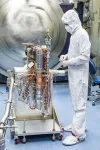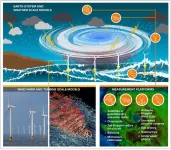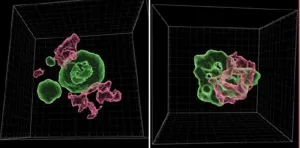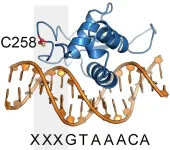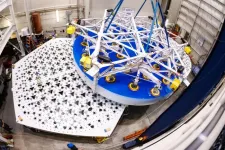(Press-News.org) SAN ANTONIO — October 15, 2024 —Two Southwest Research Institute instruments were launched aboard NASA’s Europa Clipper spacecraft on Oct. 14 from the agency’s Kennedy Space Center. The spacecraft is designed to conduct a detailed reconnaissance of Jupiter’s moon Europa, investigating whether it could hold conditions suitable for life.
The SwRI-developed MAss Spectrometer for Planetary EXploration (MASPEX) and Ultraviolet Spectrograph (Europa-UVS) are among nine science instruments and a gravity science investigation that were developed to explore Europa, Jupiter’s fourth-largest moon and one of the most likely locations for potential life in our solar system. In the 1990s, NASA’s Galileo mission yielded strong evidence that Europa, which is about the size of Earth’s moon, has a liquid ocean beneath an icy crust of unknown thickness. This global ocean could have at least twice as much water as Earth.
“The ability to characterize this ocean remotely is key — MASPEX has a mass resolution 50 times finer than anything that has flown to space before,” said SwRI Senior Vice President Dr. Jim Burch, who serves as MASPEX’s principal investigator. Burch leads the Institute’s Space Sector, with three divisions devoted to space science, solar system science and space systems. “MASPEX can differentiate between molecules with almost identical masses based on the energy binding the atoms. It also differentiates isotopes — atoms with equal numbers of protons but a different number of neutrons. These capabilities are crucial to revealing the habitability of Europa.”
SwRI internal research, NASA instrument development programs and the Europa Clipper project funded MASPEX’s development.
Europa-UVS is the sixth in a series of SwRI-built ultraviolet spectrographs, benefitting greatly from the design experience gained by its team from the Juno-UVS instrument, which is currently operating in Jupiter’s harsh radiation environment on NASA’s Juno spacecraft.
“UVS is designed to hunt down and study potential plumes emanating from surface cracks on Europa,” said Dr. Kurt Retherford, principal investigator for the UVS instrument and a senior program manager at SwRI. UVS will look at the composition and chemistry of Europa’s atmosphere to understand its source, structure and variability. It will search for and characterize plumes in terms of activity and the nature of subsurface water reservoirs.
“Once UVS detects any potential plumes, the spacecraft might fly through them, allowing MASPEX to ‘sniff’ the volatile gases,” said Burch.
The mass spectrometer is designed to measure molecular and isotopic composition of these gases, offering insight into the oxidation state of the moon’s subsurface ocean and potential metabolic energy sources for potential microbial life.
“With these precise measurements, the composition of the gases will reveal the story of the interior and whether the conditions for life exist beneath the icy surface of Europa,” Burch explained.
Another UVS is en route to Jupiter now aboard ESA’s Jupiter Icy Moons Explorer (Juice) to orbit both Jupiter and its moon Ganymede.
“Having two UVS instruments in the Jupiter system making measurements will offer exciting complementary science possibilities,” said Retherford. “Juice is primarily studying Ganymede, but it will fly past Europa twice.”
Europa Clipper is NASA’s largest solar-powered spacecraft for a planetary mission, and it will enter a long, looping orbit around the gas giant Jupiter to perform repeated close flybys of the moon over a four-year period. In total, the mission will perform nearly 50 flybys at altitudes ranging from 16 miles to 1,700 miles (25 kilometers to 2,700 kilometers).
Managed by Caltech in Pasadena, California, JPL leads the development of the Europa Clipper mission in partnership with the Johns Hopkins Applied Physics Laboratory (APL) in Laurel, Maryland, for NASA’s Science Mission Directorate in Washington. The directorate, which is responsible for planning and operating this mission, conducts a wide variety of research and scientific exploration programs for Earth studies, space weather, the solar system and the universe.
The MASPEX instrument team includes scientists from SwRI, SETI, Washington University, Arizona State University, the Imperial College London and the University of Franche-Comté. The Europa-UVS instrument team includes scientists from SwRI, The University of Texas at San Antonio, SETI, the Planetary Science Institute, Royal Institute of Technology in Sweden and the University of Cologne in Germany.
For more information, visit https://www.swri.org/planetary-science.
END
SwRI-developed instruments will study potential habitability of Jupiter’s moon Europa
Europa-UVS, MASPEX designed to characterize gases around the icy satellite
2024-10-15
ELSE PRESS RELEASES FROM THIS DATE:
Proposed scoring system may enhance equity in organ transplantation, increase transplant rates and improve patient survival
2024-10-15
Tuesday, Oct. 15, 2024, Cleveland: Researchers at Cleveland Clinic and Case Western Reserve University (CWRU) have developed a new method that could potentially help provide better access to lung transplant for transplant candidates who are hard to match because of their blood type or height.
An analysis published in the Journal of Heart & Lung Transplantation showed significant inequity in lung transplant access based on these candidate characteristics and proposes a method for addressing it.
Lung transplant candidates require organs from donors of similar height and compatible blood type. Currently, to allow equally sick candidates equal ...
Survivors of childhood brain cancer are more likely to be held back in school
2024-10-15
In 2019, Raymond Mailhot was visiting with a young patient and his family facing a scary diagnosis – brain cancer. Treatments were incredibly effective, and the young boy was going to survive, Mailhot shared in Spanish with the Venezuelan immigrants.
But life would be disrupted at home, at the hospital, and at school, likely for months, he said.
“His story really made me want to dig deeper into the scholastic performance of survivors,” said Mailhot, M.D., M.P.H, an associate professor of radiation oncology at the University of Florida. “We discovered that survivors had twice the odds of being held back and performed significantly worse on state testing ...
Updating offshore turbine designs to reflect storms’ complexity is key
2024-10-15
WASHINGTON, Oct. 15, 2024 – The U.S. is ramping up plans for a major increase in offshore wind production, with 30 gigawatts of new installations expected by 2030 and a total of 110 gigawatts by 2050. But to be successful, the country needs to design turbines that can withstand the challenges of tropical storms.
“Extreme weather impacts on offshore wind turbines are not fully understood by the industry,” author Jiali Wang said. “Manufacturers design wind turbines based on international design standards, but better models and data are needed to study the impacts of extreme weather ...
Hospital strain during the COVID-19 pandemic and outcomes in older racial and ethnic minority adults
2024-10-15
About The Study: In this cross-sectional study, older adults hospitalized with sepsis were more likely to die or experience major morbidity as the hospital COVID-19 burden increased. These increases in adverse outcomes were greater in magnitude among members of minority populations than for white individuals.
Corresponding Author: To contact the corresponding author, Laurent G. Glance, MD, email laurent_glance@urmc.rochester.edu.
To access the embargoed study: Visit our For The Media website at this link https://media.jamanetwork.com/
(doi:10.1001/jamanetworkopen.2024.38563)
Editor’s Note: Please see the article for additional information, ...
Scientists unveils key role of “selfish DNA” in early human development
2024-10-15
A critical transition in early human development is regulated not by our own genes, but by DNA elements called transposons that can move around the genome, Sinai Health researchers have found.
This remarkable discovery challenges our previous understanding of these elusive DNA segments, shedding new light on the roles they play in human development and disease.
“People tend to think of transposons as akin to viruses where they hijack our cells for the sole purpose of propagating themselves,” says study’s senior co-author Dr. Miguel Ramalho-Santos, Senior Investigator at the Lunenfeld-Tanenbaum Research Institute (LTRI), part of Sinai Health, and Professor ...
Bonobos may be more vulnerable than previously thought, suggests genetics study
2024-10-15
Bonobos, endangered great apes that are among our closest relatives, might be more vulnerable than previously understood, finds a genetics study led by a UCL researcher that reveals three distinct populations.
The three groups of bonobos have been living separately in different regions in Central Africa for tens of thousands of years, according to the study published in Current Biology by an international research team co-led by UCL, University of Vienna, and Max Planck Institute for Evolutionary Anthropology ...
Scripps Research scientists discover chemical probes for previously “undruggable” cancer target
2024-10-15
LA JOLLA, CA—Hormone-driven cancers, like those of the breast and prostate, often rely on a tricky-to-target protein called Forkhead box protein 1 (FOXA1). FOXA1 mutations can enable these types of cancers to grow and proliferate. Today, FOXA1 is notoriously difficult to block with drugs—but that may soon change.
Scripps Research scientists have identified a crucial binding site on FOXA1 that could pave the way for future cancer treatments. The team’s findings, which were published in Molecular Cell on October 15, 2024, also mapped out how tiny drug-like chemical compounds—called small molecules—interact with the protein.
While ...
Giant Magellan telescope begins primary mirror support system testing
2024-10-15
TUCSON, AZ — October 15, 2024 — The Giant Magellan Telescope today announced the successful installation of one of its completed 8.4-meter-diameter primary mirrors into a support system prototype at the University of Arizona’s Richard F. Caris Mirror Lab. This highly sophisticated system — comparable in size to half a basketball court and containing three times the number of parts of a typical car — is vital to the telescope’s optical performance and precision control. The milestone marks the start of a six-month optical testing phase to demonstrate that the support system can control the mirror as required, validating the revolutionary capabilities ...
Experimental cancer drug eliminates bone metastases caused by breast cancer in lab models
2024-10-15
In a new study led by Johns Hopkins Medicine, the drug RK-33 has demonstrated promise in treating breast cancer that has spread to the bone (breast cancer bone metastasis). RK-33 was previously shown to help treat other types of cancer and viral illnesses.
Patients with breast cancer and bone metastasis have limited treatment options and often rely on palliative care to ease difficult symptoms, including frailty and pain. In most cases, breast cancer with bone metastasis is incurable.
Now, corresponding author Venu Raman, Ph.D., ...
Political candidates who fight climate change stand to benefit in election
2024-10-15
A majority of Floridians expressed support for political candidates who fight climate change in a new Florida Atlantic University survey. The survey found that nearly 52% of respondents agreed that a candidate with a record of reducing climate impacts was more likely to get their vote.
The Invading Sea’s Florida Climate Survey also revealed strong support in the state for increasing renewable energy use and teaching climate science in K-12 classrooms. The survey is the 11th conducted by the FAU Center for Environmental Studies ...
LAST 30 PRESS RELEASES:
Routine scans could detect early prostate radiotherapy changes
Fairness in AI: Study shows central role of human decision-making
Pandemic ‘beneath the surface’ has been quietly wiping out sea urchins around the world
Tea linked to stronger bones in older women, while coffee may pose risks
School feeding programs lead to modest but meaningful results
Researchers develop AI Tool to identify undiagnosed Alzheimer's cases while reducing disparities
Seaweed based carbon catalyst offers metal free solution for removing antibiotics from water
Simple organic additive supercharges UV treatment of “forever chemical” PFOA
£13m NHS bill for ‘mismanagement’ of menstrual bleeds
The Lancet Psychiatry: Slow tapering plus therapy most effective strategy for stopping antidepressants, finds major meta-analysis
Body image issues in adolescence linked to depression in adulthood
Child sexual exploitation and abuse online surges amid rapid tech change; new tool for preventing abuse unveiled for path forward
Dragon-slaying saints performed green-fingered medieval miracles, new study reveals
New research identifies shared genetic factors between addiction and educational attainment
Epilepsy can lead to earlier deaths in people with intellectual disabilities, study shows
Global study suggests the underlying problems of ECT patients are often ignored
Mapping ‘dark’ regions of the genome illuminates how cells respond to their environment
ECOG-ACRIN and Caris Life Sciences unveil first findings from a multi-year collaboration to advance AI-powered multimodal tools for breast cancer recurrence risk stratification
Satellite data helps UNM researchers map massive rupture of 2025 Myanmar earthquake
Twisting Spins: Florida State University researchers explore chemical boundaries to create new magnetic material
Mayo Clinic researchers find new hope for toughest myeloma through off-the-shelf immunotherapy
Cell-free DNA Could Detect Adverse Events from Immunotherapy
American College of Cardiology announces Fuster Prevention Forum
AAN issues new guideline for the management of functional seizures
Could GLP-1 drugs affect risk of epilepsy for people with diabetes?
New circoviruses discovered in pilot whales and orcas from the North Atlantic
Study finds increase in risk of binge drinking among 12th graders who use 2 or more cannabis products
New paper-based technology could transform cancer drug testing
Opioids: clarifying the concept of safe supply to save lives
New species of tiny pumpkin toadlet discovered in Brazil highlights need for conservation in the mountain forests of Serra do Quiriri
[Press-News.org] SwRI-developed instruments will study potential habitability of Jupiter’s moon EuropaEuropa-UVS, MASPEX designed to characterize gases around the icy satellite

